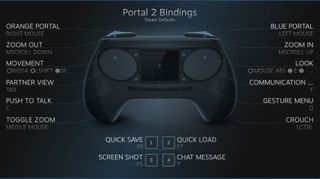Steam Controller revealed, Valve's kind of crazy Steam gamepad
The third and final Steam installment, for now

Valve's busy week of announcements came to a close today with the expected unveiling of the Steam Controller, a hackable, haptic-laden gamepad featuring an army of input options.
"A new way to play your entire Steam library from the sofa," read the third and final "living room" page Valve posted this week.
"We knew how to build the user interface, we knew how to build a machine and even an operating system," Valve continued. "But that still left input - our biggest missing link."
- Check out our Steam OS review
Input has indeed been a giant question mark for Valve's mission of bringing Linux gaming from the desktop to the living room. With the Steam Controller, Gabe Newell's crew seems confident it solved the riddle.
"[We] spent a year experimenting with new approaches to input and now we believe we're arrived at something worth sharing and testing with you."
The Steam Controller, like the Steam Box, is a prototype still. Steamers chosen for the Steam Box beta program (300 in all), will be the first to try out the new gamepad. Chances are we'll see some changes by the time the gamepad is widely available.
Steam Controller features
The key design elements of the Steam Controller aren't hard to spot.
Get daily insight, inspiration and deals in your inbox
Get the hottest deals available in your inbox plus news, reviews, opinion, analysis and more from the TechRadar team.
Prominent are two trackpads, a dual-set of thumb-controlled circular surfaces. The trackpads are clickable, turning each into one giant button.
Square in the center is a high-resolution touchscreen, one that can translate discrete touch commands while also clicking like a button. Thanks to deep Steam integration, the Controller's screen, when touched, will overlay its display onto whatever game is being played, so action can continue without having to dart eyes over to the gamepad.

The Steam Controller has 16 buttons all told, with half (including two on the back) accessible without having to take your thumbs off the trackpads, Valve said.
All buttons and controls are symmetrically placed, so right and left handedness is switchable through a software config checkbox.
The haptic feedback of the Controller is described as next-gen and "super precise," though of course we'd need to test it ourselves to see if it's really as superior as it sounds. Valve admitted that trackpads lack the visceral quality of joysticks, and therefore it wanted to add more physicality to the Steam Controller experience through haptic feedback that goes beyond the classic controller "rumble."
While Valve seemingly packed every sort of input it could, the Controller won't look as it does now when it ships to beta testers. In an FAQ, Valve explained that when the prototypes ship later this year, they will be without a touchscreen. Four buttons will replace the touchscreen and it won't be wireless either, requiring a USB cable to connect.
Keeping the old and staying open
The Controller is ageless in a way as Valve explained it's designed to work with every Steam game, past, present and future. The company accomplished this bit of trickery by "fooling older games into thinking they're being played with a keyboard and mouse."

Valve built in a legacy mode that achieves the effect the Controller presenting itself as a keyboard and mouse while relying on different control mechanisms.
Using the configuration tool, Steam Community members can create and share game bindings, and players will be able to choose from amongst the most popular configs.
Unsurprisingly, the Controller is meant to be hacked, and feedback on design is welcome.
Valve is done with announcements for now (so no more tickers) but promised details are next on the menu. We should hear more soon about the design process and how it created the current Steam Controller prototype. What's more, detailed specs of SteamOS will posted next week.
Valve always leaves us hanging, huh?
Michelle was previously a news editor at TechRadar, leading consumer tech news and reviews. Michelle is now a Content Strategist at Facebook. A versatile, highly effective content writer and skilled editor with a keen eye for detail, Michelle is a collaborative problem solver and covered everything from smartwatches and microprocessors to VR and self-driving cars.

